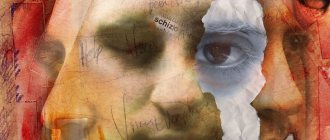How thinking changes in schizophrenia
Without constant therapy and observation by a doctor, the disease will only progress
The main feature of this disease is the development of mental pathologies while maintaining a normal level of thinking. A schizophrenic does not become weak-minded and does not fall into childhood, but during an exacerbation of the disease he may develop paranoia, hallucinations and other disorders that provoke illogical actions. The thinking of patients with schizophrenia seems to be clouded and distorted. Upon achieving remission, the patient can return to everyday activities - study, work in a team and behave like an ordinary, mentally healthy person.
However, there is currently no cure for schizophrenia. This suggests that the maximum success of therapy is remission, which may be followed by a new attack of exacerbation. To prevent this from happening, the patient should follow medical recommendations, regardless of his condition. Even if he seems completely healthy, this is not the case, and in the absence of maintenance therapy, another relapse of the disease is possible. And each subsequent exacerbation will be more severe than the previous one.
With timely and correct treatment of schizophrenia, lifelong remission can be achieved. In this case, the only reminder of the disease is the need for daily compliance with medical recommendations.
Forms of schizophrenia
Scientists identify the following classification of schizophrenia, depending on the characteristics of its course, the severity of symptoms and mental disorders.
Paranoid form
The paranoid type of schizophrenia is the most common. This disease debuts between the ages of 25 and 35 years. It is characterized by a predominance of delusional ideas and auditory hallucinations related to one topic. All other symptoms and impairment of cognitive functions are mild.
Hebephrenic form
Characteristic signs of this type of schizophrenia include foolish, demonstrative behavior, grimacing, infantilism, volitional immaturity, increased cruelty and aggression towards the weaker, fragmented thinking and inadequate emotions.
Catatonic form
It is characterized by motor disorders and changes in the volitional qualities of the patient’s personality. The symptoms of schizophrenia are determined by stupor, prolonged freezing in one position, waxy flexibility and subordination.
Simple
The diagnosis of simple schizophrenia is usually made in childhood or adolescence. It is characterized by slow, sluggish progression. Changes affect all areas - behavior, personal qualities, cognitive functions, emotions.
Manic-depressive schizophrenia
It is characterized by a sequential change of two phases - mania, with pronounced positive symptoms in the form of delusions and hallucinations, and depression. The intermediate phase is often a period of remission. Its duration depends on the effectiveness of drug therapy and preventive measures.
Only an experienced doctor can classify the disease and the form of the disease. The success of treatment depends on how correctly the diagnosis is made. There are competent psychiatrists working here. They have modern diagnostic methods - they will conduct a comprehensive examination and, based on its results, develop an individual treatment regimen.
Types of thinking disorders
With the development of schizophrenia, the patient experiences a failure of mental function. This is accompanied by the following failures:
- Aggression. The patient experiences sudden and unjustified outbursts of anger. Very often such attacks are uncontrollable, and a schizophrenic can attack the first person he meets with his fists.
- Problems with adaptation. In schizophrenia, the patient experiences impaired contact with the outside world. A person is not able to come to terms with reality, and his behavior becomes inadequate.
- Hallucinations. Many schizophrenics claim to hear voices. They can have a calming effect on the patient or control his actions. In the latter case, personal rejection is possible, when a person feels like a puppet in the hands of an invisible puppeteer. Such patients are apathetic and are not responsible for their actions.
- Rave. This is one of the most common thought disorders in schizophrenia. The patient can conduct a dialogue with a non-existent person and talk nonsense. Most patients talk to themselves in a completely empty room.
- Speech disturbances, sentences become incoherent and meaningless, tongue-tiedness appears. This condition worsens as the disease progresses.
- Indifference, apathy, complete loss of interest in the world around us, work, other people, favorite activities.
- Obsessive states in which patients are sure that they are being watched, want to be taken hostage, jinxed, etc.
Many patients become untidy as the disease progresses. This is influenced by the lack of shame, conscientiousness, inhibition of mental function and logic. They don't care about personal hygiene. Doctors mention cases when their patients could go outside without clothes or dress inappropriately for the weather.
Diagnostics
To identify the full picture of the disease, you will need to undergo many mental tests and studies.
In order for treatment of schizophrenia to bring positive results, you should contact a psychiatrist as early as possible. Only a specialist will be able to determine what symptoms and disorders indicate a disorder. Patients often confuse schizophrenia with simple neurosis, which arose against the background of stress, emotional and physical fatigue, or other mental pathologies.
To make a diagnosis, determine the form and stage of the disease, you need to go through a comprehensive examination, which includes the following points:
- collecting anamnesis, determining the clinical picture;
- conversation with the patient’s family members and close friends;
- carrying out tests: this includes several types of blood tests, urine tests, and studies of the brain and its reactions to stimuli.
Diagnosis must be carried out comprehensively - it is impossible to make a correct diagnosis from one or a couple of studies.
Treatment
Treatment of schizophrenia requires an integrated approach. Treatment is based on taking antipsychotic drugs, but on their own they can provide lasting results. To maintain remission, the patient must attend collective rehabilitation events and psychotherapeutic sessions, as well as follow all the instructions of the attending physician.
Treatment with drugs
Taken at any time, regardless of meals
The mainstay of treatment for schizophrenia is taking antipsychotics or antipsychotics. These include Risperidone, Amisulpride and Quetiapine. If taking these drugs does not give the desired results, the patient is prescribed Sertindole.
If it is impossible to take medications on a regular basis, the patient is prescribed long-acting medications. They are administered once a week intramuscularly or intravenously. We are talking about such drugs as Fluanxol-Depot, Rispolent-Consta and Klopiksol-Depot.
If typical antipsychotics do not reduce the symptoms of schizophrenia, they are replaced with drugs of the atypical group. If they do not give the desired results, then the patient is prescribed conventional antipsychotics, such as Moditen-Depot or Triftazin.
When the patient's condition is normalized, a period of remission begins. At this stage, the patient is prescribed medications to prevent the development of relapses of the disease. These include the following:
- To relieve panic attacks and depression, medications such as Valprocom and Depakine are used.
- For severe anxiety, melancholy and depression, patients take Lamitrigine.
- In case of attacks of anger and rage, as well as pain due to touching the skin, the patient is prescribed Carbamazepine.
- For apathy, the patient is prescribed lithium salts.
The duration of anti-relapse therapy depends on the attack after which it is carried out. In this case, you must adhere to the following algorithm:
- After the first episode of schizophrenia, the duration of rehabilitation therapy is about 2 years.
- If we are talking about a second attack, then the period of taking maintenance medications increases to 5 years.
- After the third exacerbation, the patient will have to take medications for life. If you stop taking antipsychotics at this stage of treatment for schizophrenia, a relapse of the disease will occur a year or two after that.
As part of anti-relapse therapy, antipsychotics are taken in extremely low dosages, amounting to a fifth of the standard treatment dose.
Anti-relapse therapy has the following goals:
- Prevent exacerbation of the disease.
- If it is not possible to avoid a relapse, then everything possible is done to postpone it for as long as possible.
- Provide the patient with social adaptation. Prevent speech disorders, problems with attention and memory. The person gradually returns to his usual way of life. After completing rehabilitation, he can return to work or school, daily activities, hobbies, etc.
Psychotherapy
Sessions with an experienced psychotherapist are very important for people with mental disorders
Psychosocial therapy is aimed at achieving maximum labor and social rehabilitation of a patient who has suffered an exacerbation of schizophrenia. The technique involves the use of one of several approaches to solving the patient’s personal problems.
The most effective psychotherapeutic techniques are:
- Cognitive behavioral therapy. It is used to reduce the severity of negative symptoms (we are talking about disorders of thinking, memory, attention, etc.). The technique is aimed at developing self-esteem in a person and facilitating the process of his subsequent social adaptation. In addition, properly administered cognitive behavioral therapy can reduce the frequency of relapses of the disease.
- Family therapy. It involves teaching the patient’s relatives and friends how to communicate with a person who has suffered an exacerbation of schizophrenia. The patient's family should have a friendly and calm atmosphere. Since schizophrenics often withdraw into themselves, one of the main tasks of family therapy is to create a trusting relationship between the patient and his relatives.
- Conversations with a psychotherapist. The speed of rehabilitation of the patient and the duration of remission of schizophrenia largely depend on communication with the doctor.
Schizophrenia (general characteristics)
Schizophrenia is a mental illness with a long-term chronic course, leading to typical personality changes (schizophrenic defect). This disease is characterized by a kind of discordance (splitting, disunity) of thinking, emotions and other mental functions. The term schizophrenia literally means “splitting of the soul” (“schizo” from Greek - splitting, “phren” - soul, mind). Schizophrenic personality changes are expressed in increasing isolation, isolation from others, emotional impoverishment, decreased activity and purposeful activity, loss of unity of mental processes and peculiar thinking disorders.
These painful changes in the psyche are also called deficiency or minus symptoms, because they constitute a defect in the patient's personality. The development of such a personality deficit (defect) is closely related to various mental disorders that are not absolutely specific to this disease, but reflect its clinical picture.
These so-called secondary or productive disorders (pathological brain production) can be represented by various mental disorders: hallucinations, delusions, decreased or increased mood, a state of lethargy or agitation, confusion. The causes of schizophrenia and the mechanisms of its development are not well understood.
The leading role belongs to hereditary factors. Gender and age are of great importance in the development of the disease. In men, the disease begins earlier and often proceeds continuously with a less favorable outcome. For women, the paroxysmal course of the disease is more typical, which is to a certain extent associated with the cyclical nature of neuro-endocrine processes (menstrual function, pregnancy, childbirth), and the prognosis is generally more favorable. Malignant forms of the disease usually begin in childhood and adolescence.
Symptoms and course:
The clinical picture of schizophrenia is represented by a wide range of psychopathological manifestations. The most typical are disorders of the intellect and emotions. With thinking disorders, patients complain of the inability to concentrate thoughts, difficulties in assimilation of material, uncontrollable flow of thoughts, blockage or stopping of thoughts, parallel thoughts.
At the same time, they are characterized by the ability to capture special meaning in words, sentences, and works of art. They can create new words (neologisms), use certain symbolism and abstraction that only they understand when expressing their thoughts and in their creativity.
It can be difficult to grasp the meaning of their speech due to the florid, logically inconsistent presentation of thoughts. In patients with a long-term unfavorable course of the disease, there may be discontinuity of speech (loss of semantic connection between individual parts of a sentence) or incoherence (a set of words).
In addition, patients may experience obsessive thoughts (thoughts that arise against the will of a person and are alien to his personality, which he recognizes as painful, but which he cannot get rid of). This is an obsessive reproduction in memory of dates, names, terms, obsessive counting, obsessive fears, ideas, reasoning. The patient may spend a long time thinking about the meaning of life and death, why the Earth is round and the Universe is infinite, etc.
The patient fights his obsessive thoughts with the help of obsessive actions - rituals that bring him relief for a certain time. So, for example, if there is a fear of contracting an infectious disease or simply a fear of dirt, the patient must wash his hands a strictly certain number of times. If he does this, he calms down a little, if not, then fear and anxiety intensify.
Patients may have delusional ideas, erroneous judgments and conclusions that arise on a painful basis, completely take over the patient’s consciousness and cannot be corrected (the patient cannot be dissuaded). Delusional ideas can arise primarily, through a painful interpretation of real facts and events, and secondarily, i.e. based on impaired perception (hallucinations).
Delusional ideas can have different contents: persecution, poisoning, witchcraft, influence, jealousy. Very typical for patients with schizophrenia is delusion of physical influence, when it seems to them that they are being affected by hypnosis, electromagnetic or x-ray radiation with the help of special installations, transmitters, both from Earth and from space.
At the same time, patients hear in their heads the “voices” of those people who influence them, control their thoughts, emotions, and movements. They can also see “films” or “special pictures” that are shown to them by imaginary people (whose voices they hear), smell various smells, often unpleasant, experience painful sensations in the body and head in the form of burning, transfusion, drilling, shooting. Deceptions of perception (auditory, visual, olfactory, gustatory, tactile) or the perception of imaginary objects and stimuli are called hallucinations.
Emotional disturbances begin with the loss of a sense of affection and compassion for parents and loved ones, the disappearance of interest in study, work, isolation, and isolation. Sometimes patients become rude, angry towards loved ones, and treat their parents as strangers, calling them by name and patronymic. The sense of responsibility and duty disappears, which is reflected in behavior. Patients stop fulfilling their duties, take care of their appearance (they don’t wash, don’t change clothes, don’t comb their hair), wander around, and do ridiculous things.
Along with these deficiency symptoms, patients during an exacerbation may have a depressed (depressive) or elevated (manic) mood. Patients experience a pronounced decrease in volitional activity (purposeful activity), leading to complete indifference (apathy) and lethargy. Moreover, the severity of volitional disorders, as well as emotional ones, correlates with the severity of the personality defect. The so-called apato-abulic syndrome forms the basis of the schizophrenic defect.
Characteristic of patients with schizophrenia are peculiar motor-volitional disorders (catatonic). The patient may be in a state of catatonic stupor (complete inhibition). Such patients can lie for a long time (sometimes weeks, months) in the uterine position with their knees bent and their legs pressed to their stomach, without reacting to others, without answering questions, without following any instructions.
They refuse to eat, and the staff is forced to force-feed them (through a tube) to avoid starvation. Some patients experience the air cushion symptom, in which they lie on their backs with their heads elevated above the pillow. Long-term preservation of a certain position by patients is possible due to their existing waxy flexibility, which appears as a result of a peculiar redistribution of muscle tone.
Patients can maintain an artificially given position for quite a long time. Refusal to follow instructions (negativism) can be passive (simply does not respond to words) and active (does the opposite). Patients may experience unfocused, chaotic arousal (catatonic) with stereotypical actions, increased aggressiveness, and unpredictability of actions.
Such patients may have echo symptoms when they repeat words, movements, or copy facial expressions after someone around them. Patients in this condition can be dangerous to themselves (self-harm) and others (aggressive actions) and should be immediately hospitalized.
A catatonic state may be accompanied by dreamlike hallucinations of fantastic content (waking dreams or oneiric stupefaction. One of the most unfavorable, malignant symptoms is the state of hebephrenia - agitation with foolishness, mannerism, pretentiousness of movements and speech. Patients grimace, tease, distort words, make various jokes. Their behavior is not controllable and predictable. This state often gives way to catatonic excitement.
As can be seen from the above, the clinical manifestations of schizophrenia are varied, but have their own characteristics. The outcomes of the disease are also different, from barely noticeable personality changes that have little effect on social adaptation, to a deep defect that makes it impossible for the patient to stay outside the hospital. These differences are associated with the course of the disease, the degree of its progression, and the age of onset of the disease.
There are three types of schizophrenia:
- continuous;
- periodic (recurrent schizophrenia);
- fur-like (from the word “fur” - shift, attack).
Recognition:
It is difficult only at the beginning of the disease. If the first attack in periodic schizophrenia is represented by purely emotional disorders, it is difficult to differentiate it from the phase of manic-depressive psychosis. Certain difficulties arise when diagnosing schizophrenia in childhood, since the first pronounced attack is usually noted only in adolescence.
In children, symptoms of the disease include movement disorders, fears, and obsessions. Hallucinations are predominantly visual, instead of delusional ideas, delusional fantasies. Depression is expressed mainly in lethargy, moodiness, and discontent.
Elevation of mood is manifested by motor disinhibition, cheerfulness, and fussiness. In some cases, psychological testing is used for diagnosis to determine the characteristics of the character, level and type of thinking.
Treatment
The diagnosis is established on the basis of anamnesis, interviews with the patient, his friends and relatives. To make a diagnosis of schizophrenia, one or more first-rank criteria and two or more second-rank criteria defined by ICD-10 must be present. The criteria of the first rank include auditory hallucinations, the sound of thoughts, fanciful delusional ideas and delusional perceptions. The list of criteria for schizophrenia of the second rank includes catatonia, interruption of thoughts, persistent hallucinations (except auditory), behavioral disturbances and negative symptoms. Symptoms of the first and second ranks must be observed for a month or more. To assess the emotional state, psychological status and other parameters, various tests and scales are used, including the Luscher test, Leary test, Carpenter scale, MMMI test and PANSS scale.
Treatment of schizophrenia includes drug therapy, psychotherapy and social rehabilitation measures. The basis of pharmacotherapy are drugs with antipsychotic effects. Currently, preference is often given to atypical antipsychotics, which are less likely to cause tardive dyskinesia and, according to experts, can reduce the negative symptoms of schizophrenia. To reduce the severity of side effects, antipsychotics are combined with other medications, usually mood stabilizers and benzodiazepines. If other methods are ineffective, ECT and insulin comatose therapy are prescribed.
After the reduction or disappearance of positive symptoms, the patient with schizophrenia is referred to psychotherapy. Cognitive behavioral therapy is used to train cognitive skills, improve social functioning, and help people understand the characteristics of their own condition and adapt to this condition. To create a favorable family atmosphere, family therapy is used. They conduct training sessions for relatives of patients with schizophrenia and provide psychological support to relatives of patients.
Forecast
Prognosis for schizophrenia
The prognosis for schizophrenia is determined by a number of factors. Prognostically favorable factors include female gender, late age of onset of the disease, acute onset of the first psychotic episode, mild severity of negative symptoms, the absence of prolonged or frequent hallucinations, as well as favorable personal relationships, good professional and social adaptation before the onset of schizophrenia. The attitude of society plays a certain role - according to research, the absence of stigma and acceptance of others reduces the risk of relapse.











